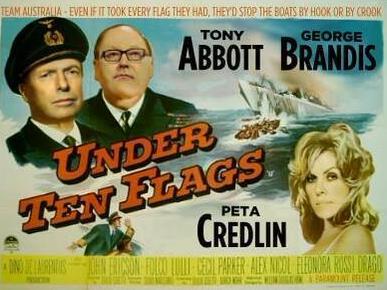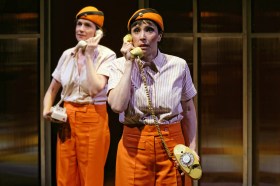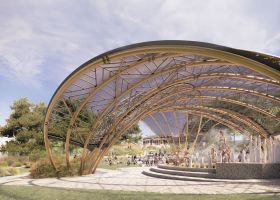Image: The Art of Brandis
For even the most experienced arts manager, for whom uncertainty about funding is a certainty, the past few weeks have been more than tough. As a sector we are used to working within the context of changing funding structures and limited resources but since the Federal Government announced cuts of $104.8 million to the Australia Council for the Arts for the establishment of the National Program for Excellence in the Arts (NPEA), we are faced with a whole new landscape. For many of us, months, and in some cases years of strategic development and change with the possibility of new beginnings and exciting growth has become an air of uncertainty, palpable loss and a strong sense of having to weather the storm ahead.
However, this disruption has certainly been unifying.
During these past weeks, I have seen our diverse and to be honest, occasionally discordant sector stand together, speak together and push back.
Together we have rallied; we have held local, regional and national meetings. We have pooled our resources to create campaign materials, collated our audience and programming data to support our arguments and even shared travel costs to ensure our sector was effectively represented in Canberra before the Budget was passed. And while we still don’t have certainty, we are being heard. A Senate Inquiry is underway and more than 2,000 submissions have been made by concerned individuals and organisations.
Support has also come from corners we may not always turn to. Accountants have written submissions, local governments have advocated for arts in their local community, tourism organisations and business advocacy groups have contributed testimonials about the economic value of the arts.
For Footscray Community Arts Centre and the communities we engage with, the arts have always been a vehicle for social justice. Our programming vision is firmly sighted on amplifying the voices that are often silenced when louder, more privileged voices are in control. We partner with artists and organisations that are working with marginalised communities; we provide a creative and culturally safe space for people to gather, celebrate, share and make work.
We know that art can and does create change.
For me, this is where the future of arts advocacy can be found. Whilst arts funding is at the forefront of what we have been fighting for, the core of this moment in time is essentially about principles. It is social justice, equity and human rights. It is about freedom to engage in artistic and personal expression.
We are fighting for diversity and representation in the Australian civic narrative.
In the past weeks, we have really seen the strategic and tactical capabilities of the arts and cultural sector. We can now further understand our capacity to agitate; we can see our strengths more clearly; and we can also see the areas we need to further develop together. We have also seen the power of our audiences, which are the most powerful voices we have. Now is the time to leverage our collective resources to transcend sector-specific commentary.
We will be nailing arts advocacy when we are one of the loudest voices on non-arts specific issues.
Audiences are communities. Communities are both local and global. The arts can be the primary tool for amplifying social, cultural and political issues. This is why we are under threat.
How can we use our platforms to fight the censoring of doctors and health workers in detention centres who are trying to protect and support the very communities that the arts and community sectors will be working with in years to come? Where is our collective voice on the forced closures of Aboriginal communities in Western Australia? How do we activate our audiences to demand more funding for family violence services? What is our role in representing community concerns to those in Government?
The history and mission of Footscray Community Arts Centre clearly articulates the position we take on many social and policy issues, and the programs artists and communities seek us out to collaborate on, reinforce this. Our members, audiences and partners expect us to be vocal on social justice issues beyond the arts.
I recognise that for many organisations the boundaries of their organisational purpose may not be so defined. But we can still ask our audiences, our communities, what issues are they concerned about? Where and how do they want to see us take action? For answers, we can look at the types of works that are drawing audiences and the feedback we receive. We can take note of the commentary on our social media and conversations with our members. We don’t know what we don’t know; let’s ask the questions.
Once we know, we can incorporate this into our strategies and the partnerships we are building. We can also think about how we ensure we are actively developing the audiences of the future, the next generation of thought leaders, artists, critics, policy makers, arts managers and leaders.
And when we do this, when we participate and advocate beyond our own interests, our sector becomes less vulnerable to funding cuts and policy changes. We become a collection of voices representing and amplifying community interests and concerns across all sectors and important social issues.
Let’s not pretend that art for art’s sake is a ‘thing’. No one makes art simply to be consumed and forgotten. We all make art to be shared, to be heard, seen, felt and reciprocated. A composer writes music to be shared, a visual artist exhibits to share and create dialogue, and theatre makers are writing a generation of stories. We don’t make work ‘about art’. Art is the tool to share and tell our stories. We make art about family, relationships, the environment, our daily lives and the world, so why wouldn’t we, as a sector consider ourselves the facilitators and convenors of the big conversations, the world around us.
The future of arts advocacy is to value what we ‘do’, the role we ‘play’, the voices we ‘have’, and to always activate our sphere of influence: audiences(communities), policy makers, politicians, corporate CEOs, our families; to do what they don’t expect us to do and talk about the issues we make work about, as opposed to the ways in which we make it.
This article was commissioned and first published by NAVA.





